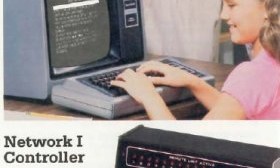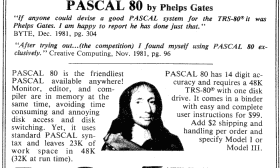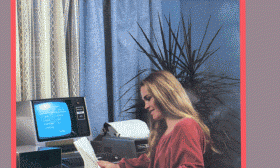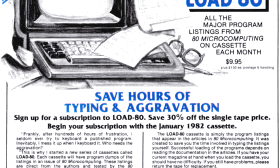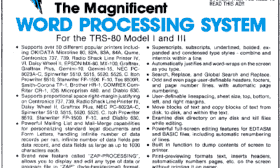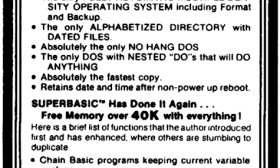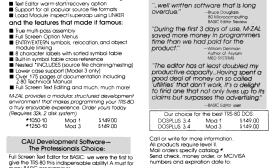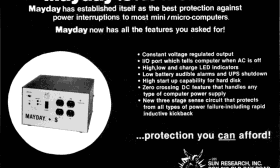The Radio Shack Network I Controller (catalog number 26-1210) was an early networking system for the TRS-80. Introduced on March 1, 1980, the Network I Controller (originally called the TRS-80 Model I Network I) cost $499.00 and was primarily designed for classroom use.
The Network I concept, described as “teacher-centric,” was based around a disk-based Model I (used by a teacher) connected through a Network I Controller and cassette cables to cassette-based Model I’s (used by students). Up to sixteen student computers could be connected over a distance of up to thirty feet. From the announcement in the TRS-80 Microcomputer News:
(Read more...)
The TRS-80 Model 4, introduced in 1983, was 100% software compatible with its predecessor, the TRS-80 Model III. A cassette-based Model 4 behaved identically to a cassette-based Model III and could run all Model III software. But a disk-based Model 4 could also run new Model 4 software that exposed features unique to the Model 4, such as extra memory and a larger text resolution. For Model III owners who wanted to run the new software but were unwilling to discard their Model III, Radio Shack offered the Model III to 4 Upgrade Kit.
The Model III to 4 Upgrade Kit (catalog number 26-1123) originally cost $799.95 and was introduced at the same time as the Model 4. It could convert a disk-based Model III into a disk-based Model 4, capable of running all Model 4 programs. One early Model 4 advertisement stated that “Model III disk system owners can get all the new Model 4 features by adding our upgrade kit.”
The Model III to 4 Upgrade Kit consisted of several parts:
(Read more...)
Pascal 80 was a Pascal development system for the TRS-80 Model I, III, and 4. It was written by Phelps Gates, also the author of APL-80, an APL compiler for the TRS-80.
The Pascal 80 package consisted of a full-screen text editor, monitor, and compiler. Pascal source code could be compiled directly to memory or to disk. Editing and compiling Pascal source code in memory made programming Pascal similar to using interpreted languages, such as BASIC. According to the Pascal 80 manual:
Efficient and compact code allows Pascal 80 to have a monitor, editor, and compiler in the computer at the same time, yet leave enough room to create programs up to 23K bytes, with an additional 9K available while the program is running for variables and work space. This allows programs to be written, compiler, edited, and compiled again without time consuming disk access.
When written to disk, resulting programs could either be created as p-code (an intermediate compiled format) or could be merged into standalone /CMD files.
(Read more...)
80 Microcomputing, also known as 80 Micro, was the most famous of the TRS-80 magazines and the best remembered. It was the first of the platform-specific computer magazines to become very popular, creating a model that many other magazines followed. Harry McCracken, former editor-in-chief of PC World, described PC World as “essentially an 80 Micro clone that happened to be about Windows, not TRS-80’s.”
80 Microcomputing published for 101 issues from January 1980 to June 1988, plus one special anniversary issue in 1983. With the combined June/July 1982 issue, 80 Microcomputing was renamed to 80 Micro and the cover date was advanced one month.
The magazine was very successful and spawned:
(Read more...)
Like most early microcomputer magazines, 80 Microcomputing published many reader submitted programs. These programs were among the most popular features of the magazine but needed to be typed into a computer before they could be used. Typing in long program listings was time consuming and there was always the real possibility of introducing errors during the typing process.
Selling a tape containing the programs from 80 Microcomputing was an idea mentioned almost from the beginning of the magazine. That idea eventually led to the product named LOAD-80. Wayne Green, the publisher of 80 Microcomputing, first referred to LOAD-80 in his “80 Remarks” column in the April 1981 issue:
(Read more...)
Computer software has always used version numbers, but there have been many different ways of managing them. (For an interesting history of version numbers, see the article The Amazing World of Version Numbers by Harry McCracken.)
Most personal computer software followed a consistent pattern of major and minor version numbers. I found this description of the Radio Shack approach to version numbering from the TRSDOS and DISK BASIC Reference Manual to be interesting:
(Read more...)
Zorlof the Magnificent was a powerful word processor for the TRS-80 Model I and III. It was written by Peter Ray and sold by Anitek Software Products of Melbourne, Florida. Released in 1982 for a price of $69.95, Zorlof was often described as a “second-generation word processor,” one generation beyond Electric Pencil and Scripsit.
Zorlof was a full-screen word processor that supported lowercase on the Model I. It provided 61 editing functions, which included common tasks such as deleting lines, global search and replace, and block moves. Word-wrapping and justification were automatically handled by Zorlof. As it stated in the manual:
(Read more...)
MULTIDOS was one of the major TRS-80 operating systems, described in advertisements as “the most compatible, user friendly operating system on the market.” It was written by Vernon Hester, the author of ULTRADOS, and was in some ways a continuation of that operating system. MULTIDOS was the least expensive TRS-80 operating system and also the one with the most recent update (MULTIDOS 5.1 in 2005). It was also the only TRS-80 operating system to offer software compatible versions for the TRS-80 Model I, Model III, Model 4, and the Lobo MAX-80.
ULTRADOS was an earlier TRS-80 operating system for the Model I that was sold by Level IV Products. After Vernon Hester parted ways with Level IV Products in 1981, he began writing a completely new operating system. This operating system, which was briefly advertised as ULTRA-II, soon became known as MULTIDOS. Vernon Hester originally sold MULTIDOS through his company, Cosmopolitan Electronics Corporation. The Model I version of MULTIDOS was released in late 1981 and the Model III version was released in January 1982. The price started out at $79.95 but soon increased to $99.95. Later on, MAX-80 MULTIDOS was released in late 1983 and Model 4 MULTIDOS (originally known as MULTIDOS 80/64) in 1985.
(Read more...)
M-ZAL was a powerful disk-based editor assembler system for the TRS-80 Model I and III. First introduced in 1981, M-ZAL (which stood for Modular Z80 Assembly Language) was written by Jeffrey Krantz and David Willen. It was sold by Computer Applications Unlimited (also known as CUA) for the price of $149.95.
Although expensive, M‑ZAL was one of the most advanced assemblers ever written for the TRS-80 and it was used by many professional TRS-80 developers. The advertisements contained endorsements from several TRS-80 authors, including:
(Read more...)
Mayday was a line of uninterruptible power supplies for the TRS-80 and other computers. It was sold by Sun Research (originally Sun Technology), a division of Phase-R Corporation.
Phase-R Corporation was located in New Durham, New Hampshire and experienced frequent problems with poor power quality and frequent outages. They originally developed the Mayday to protect the office TRS-80’s, describing it as “designed and developed using a complete TRS-80 system.” Sun Research introduced the first Mayday model in 1980.
(Read more...)
